William Shakespeare. Revered throughout the world as one of the greatest playwrights, Shakespeare wrote some of the best-known and best-loved words in the English language. Over 400 years on, these words still have the power to question, console, illuminate and inspire us today.
Although he may have been a native of Warwickshire, it was London that made William Shakespeare’s name. London was the city in which he spent the greatest part of his life and it was London that provided the location, audiences, and often the inspiration for his plays.
Modern London is a very different place from the city Shakespeare would have known. But, there are still a few locations where you can discover tantalising traces of Shakespeare’s life and legacy.
1. The Theatre, Shoreditch
Along Curtain Road, you will find a green plaque to the first permanent, purpose-built theatre in London. Built-in 1576, it was called, The Theatre.
People had been performing in London since medieval times. But the construction of purpose-built theatres in which professional actors performed to public audiences for a profit was a new and radical innovation in mass entertainment.
It was here that Shakespeare wrote and performed as a member of the acting company called the Lord Chamberlain’s Men. But, in 1598, the company fell out with the owner of the land on which The Theatre stood. So they dismantled The Theatre, transported its timbers across the river Thames and used them to construct a new theatre which became known as The Globe.
2. Shakespeare’s Globe Theatre, Bankside
One of the most iconic theatres in London, Shakespeare’s Globe Theatre, which opened in 1997, is a reconstruction of the original built-in 1599. Plays are on throughout the summer, offering a unique insight into the intimacy and immediacy of performance in a space Shakespeare would hopefully recognise.
400 years ago, you would pay 1 penny to stand in the yard around the stage. You were known as a groundling or a penny stinkard. It was then common practice to chew raw garlic as a way of preventing plague and, as plays lacked intervals and the theatres were not equipped with toilets, it’s possible the audience may have relieved themselves in the theatre. It costs £5 to stand in the yard to watch a play today and there are toilets!
As well as modern conveniences, there are a few health and safety features. The first Globe famously burned down in 1613. During the production of Shakespeare’s play Henry VIII, wadding from a stage canon ignited the thatched roof and the theatre burnt to the ground in 2 hours. Everyone inside managed to escape unharmed, except one man whose breeches caught on fire! Luckily, this was put out by a bystander with a bottle of beer. If you look carefully at The Globe’s thatched roof, you may notice the spikes of the water sprinkler system used today, though beer is still sold (just in case).
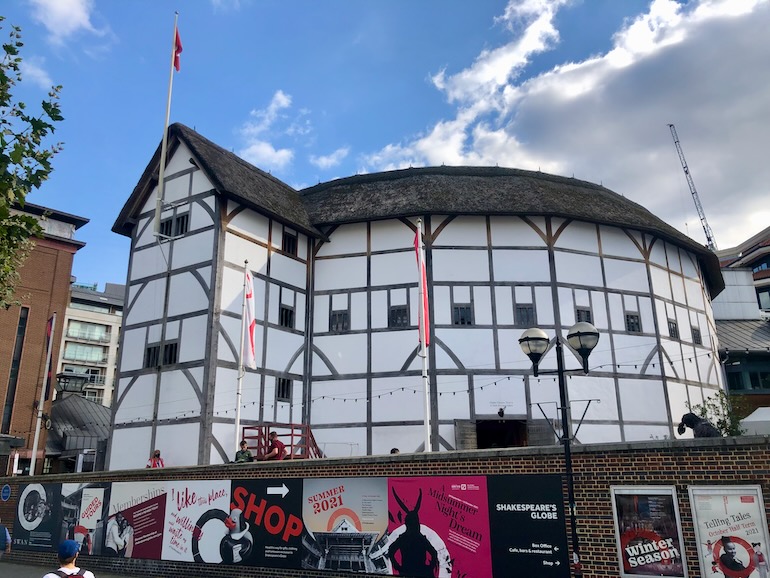 Shakespeare’s Globe – the Globe Theatre and the Sam Wanamaker Playhouse. Photo Credit: © Ursula Petula Barzey.
Shakespeare’s Globe – the Globe Theatre and the Sam Wanamaker Playhouse. Photo Credit: © Ursula Petula Barzey.
3. Bankside
In Shakespeare’s time, the City authorities loathed theatre. In fact, in 1574, they passed a law forbidding the construction of playhouses within the City of London. This meant the theatres were mainly located in the suburbs on the outskirts of the City, in areas outside its jurisdiction.
One such place was Bankside. 400 years ago, this was London’s growing entertainment venue. Here, you could find something to suit every pleasure and pocket, including bear baiting which is alluded to in the name of the street Bear Gardens. Though it may seem barbaric to us today, in Elizabethan times it was very popular. Indeed, although Queen Elizabeth I never visited the theatres she regularly went to see bear-baiting. Individual bears became celebrities; one called Sackerson is mentioned in Shakespeare’s Merry Wives of Windsor.
At the end of Bear Gardens is Park Lane, which reveals a seedier side of Bankside’s past. This street was originally called Maiden Lane, a tongue-in-cheek reference to women who plied their trade in the stews or brothels located here. There were once 23 brothels in this area, all licensed by the Bishop of Winchester.
4. The Rose Theatre, Bankside
Discovered in 1989, the remains of The Rose Theatre (built-in 1587) provided the first physical evidence of an Elizabethan playhouse.
Archaeologists uncovered three-quarters of the theatre’s ground plan as well as over 700 objects, including the earliest fork found in London. The archaeology was complemented by a wealth of documentary evidence. The builder of The Rose, Richard Henslowe, was a meticulous bookkeeper, recording his expenditure on the theatre, box office takings, the plays staged there, hiring of actors, purchasing and storage of props, scenery, and costumes. This means we know more about The Rose than any other contemporary theatre. We know, for example, that Shakespeare’s Henry VI and Titus Andronicus premiered at The Rose.
Today, the remains of The Rose are preserved beneath a raised office block. Plays are still performed there, mere yards away from the stage of the original theatre.
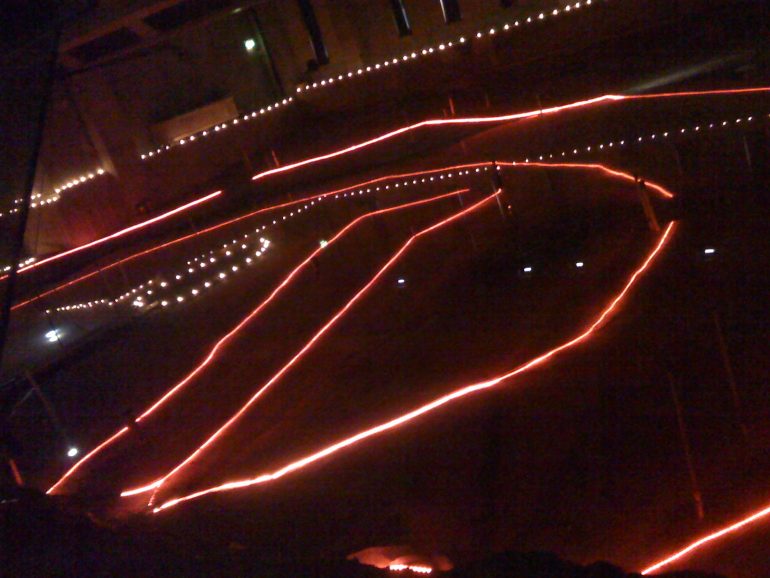 Excavation of the Rose Theatre, Bankside. Photo Credit: © David Sim via Wikimedia Commons.
Excavation of the Rose Theatre, Bankside. Photo Credit: © David Sim via Wikimedia Commons.
5. Site of the original Globe Theatre
Opposite The Rose, you can find the site of the original Globe Theatre. Only about 5% of the theatre has been excavated; the rest lies beneath a listed Georgian building and Southwark Bridge.
In 1949 an American actor called Sam Wanamaker came here. He wanted to see the location of The Globe Theatre, but was disappointed to discover that the only thing to mark the site where this theatre had once stood was the plaque you can see there today, then set in a wall of the Anchor Brewery.
In 1970, Sam set up the Shakespeare’s Globe Trust to actively pursue his dream of building a reconstruction of the original Globe Theatre. It took 23 years to find land, get planning permission and raise the money for the work. Sadly, Sam never saw his vision completed. He died in 1993, while the building was still under construction. But it is thanks to him that we have The Globe Theatre today and The Globe’s new indoor theatre, the Sam Wanamaker Playhouse, is named in his honour.
6. The George Inn, Southwark
The last galleried inn in London, the George Inn provides an insight into the kind of establishment used by acting troupes before the purpose-built theatres.
The present building, dating from 1676, stands on the site of an inn built around 1542. It once surrounded 3 sides of the courtyard. The actors would perform on a stage erected in the centre of the courtyard and the audience would either stand around them or pay a premium to sit in the galleries with a better view.
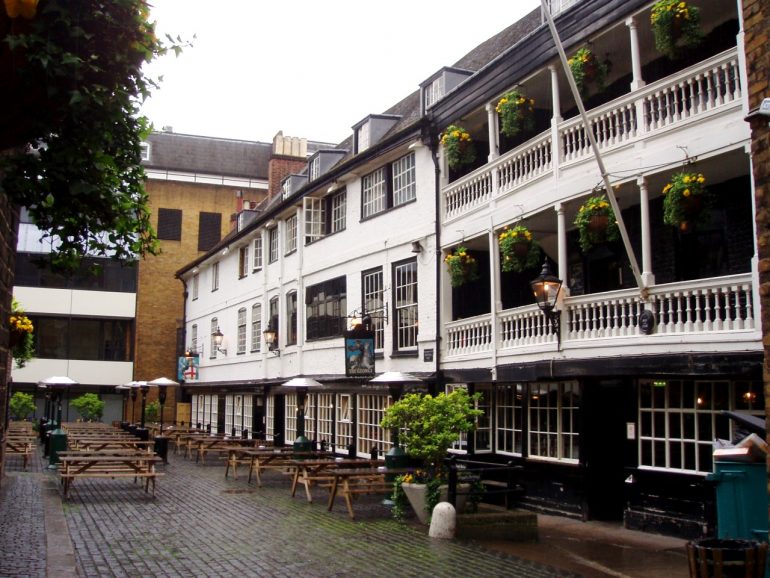 The George Inn. Photo Credit: © Ewan Munro via Wikimedia Commons.
The George Inn. Photo Credit: © Ewan Munro via Wikimedia Commons.
7. Playhouse Yard, Blackfriars
This was the location of the indoor Blackfriars Theatre, regarded as the template from which subsequent indoor theatres evolved.
Situated in a converted hall in what had been a huge monastic complex, it was first used by Shakespeare’s acting company, now known as the King’s Men under the patronage of James I, in 1609.
It is widely believed that Shakespeare’s The Winter’s Tale and Cymbeline were written with the Blackfriars Theatre in mind. It was a very different theatre to the Globe. The audiences were much smaller and the entry prices more expensive, making it a more intimate, exclusive space. Being indoors meant that performances were illuminated by candlelight. This allowed for lighting effects not possible at the Globe, where the plays were lit by daylight. It also made it necessary to stop the plays to trim the candle wicks, leading to the introduction of intervals.
8. Southwark Cathedral
In Shakespeare’s time, Southwark Cathedral was the parish church of St Saviour’s and St Mary Overie (‘over the water’). Wenceslaus Hollar’s panoramic artworks depicting London were drawn from an earlier tower of the church and provide the most reliable visual record of The Globe and its neighbouring theatres. The church itself is one which Shakespeare would have known. His brother Edmund was buried here in 1607. Along the south aisle of the present Cathedral, stands a monument to Shakespeare created in 1912. There is also a memorial to Sam Wanamaker.
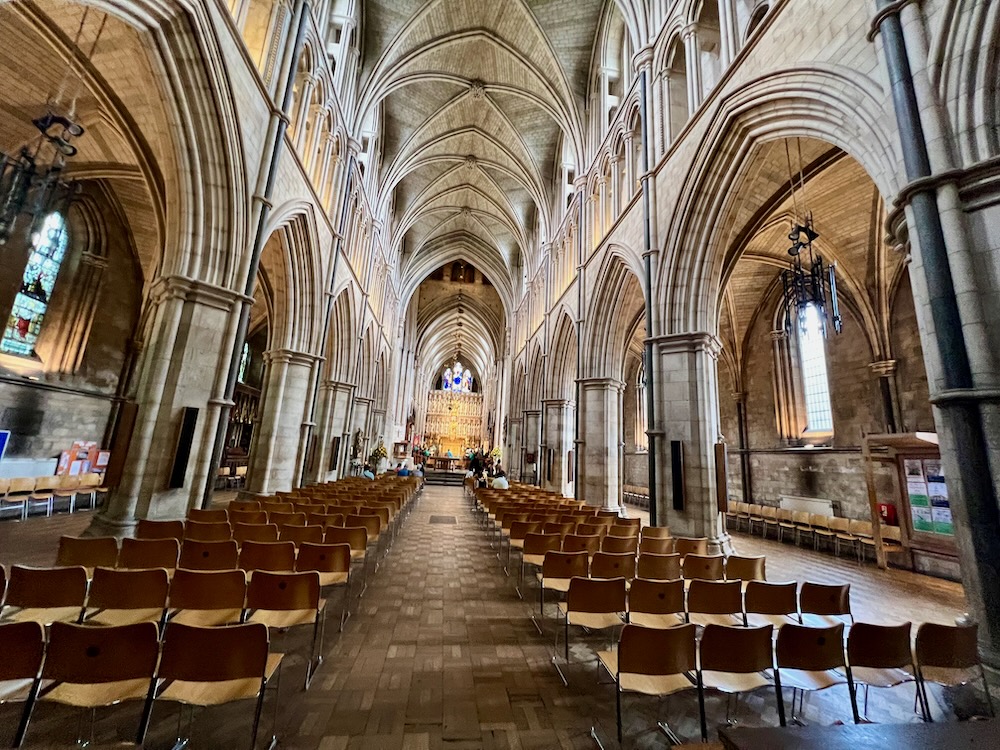 Southwark Cathedral in London. Photo Credit: © Ursula Petula Barzey.
Southwark Cathedral in London. Photo Credit: © Ursula Petula Barzey.
9. The Cockpit Pub
This marks the approximate site of the old Priory Gatehouse, which Shakespeare bought for £140 in 1613. The deed of purchase for the property still exists today in the London Metropolitan Archives. It contains one of only 6 ‘authenticated’ examples of Shakespeare’s signature.
Although Shakespeare owned property in Stratford upon Avon, this is the only property he is known to have owned in London. There is no evidence to suggest that he lived there, but, given its close proximity to the Blackfriars Playhouse and the Globe, it’s possible that William Shakespeare may have intended to make it his home.
10. Love Lane Gardens
This bust of William Shakespeare stands as a memorial to his fellow actors, Henry Condell and John Hemmings, who was buried in the churchyard of St Mary Aldermanbury nearby. They were instrumental in collating and printing what became the First Folio of Shakespeare’s works, the first and most authoritative collection of 36 of Shakespeare’s plays, published in 1623 (7 years after his death).
The First Folio is the main reason so much of Shakespeare’s work is known and survives today. Without it, many of his plays including Twelfth Night, The Tempest, or Macbeth would have been lost. And without the plays, there would be no William Shakespeare.
Want to find out more? Why not let one of our expert Blue Badge Tourist Guides bring the life and times of William Shakespeare’s London to life.



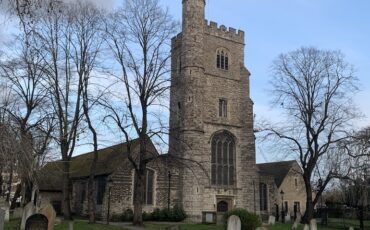
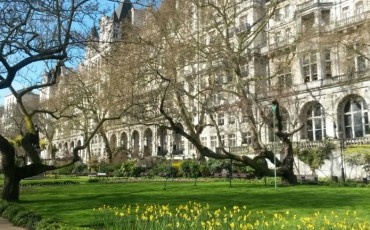


I hope i can use this for my literature project about Shakespeare’s relevance to today